headlamp VOLVO V90 2017 User Guide
[x] Cancel search | Manufacturer: VOLVO, Model Year: 2017, Model line: V90, Model: VOLVO V90 2017Pages: 594, PDF Size: 15.07 MB
Page 142 of 594
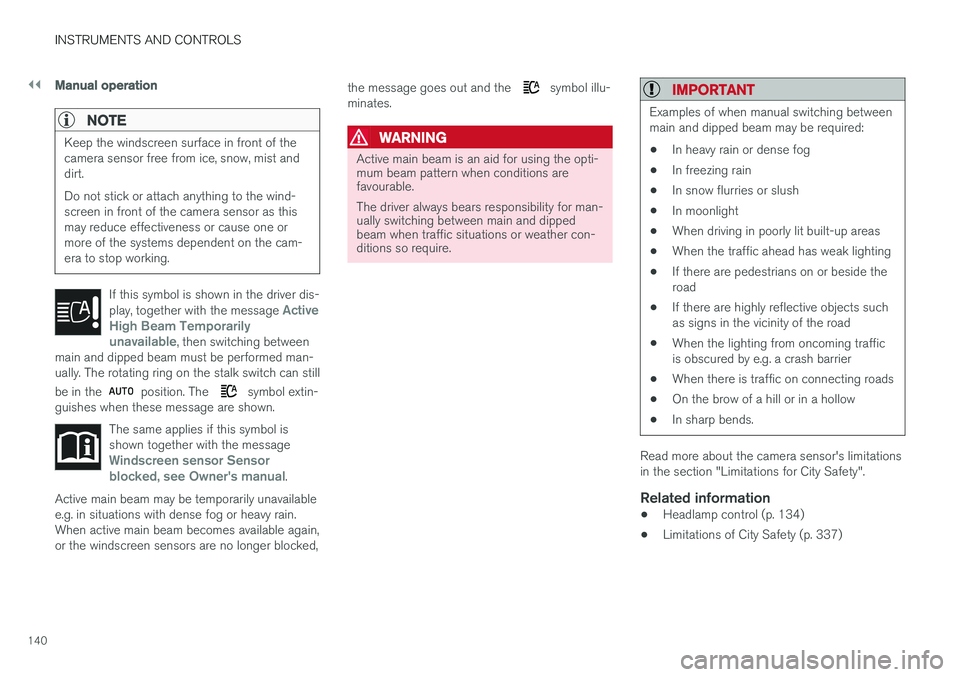
||
INSTRUMENTS AND CONTROLS
140
Manual operation
NOTE
Keep the windscreen surface in front of the camera sensor free from ice, snow, mist anddirt. Do not stick or attach anything to the wind- screen in front of the camera sensor as thismay reduce effectiveness or cause one ormore of the systems dependent on the cam-era to stop working.
If this symbol is shown in the driver dis- play, together with the message Active
High Beam Temporarily
unavailable, then switching between
main and dipped beam must be performed man- ually. The rotating ring on the stalk switch can still be in the
position. The symbol extin-
guishes when these message are shown.
The same applies if this symbol is shown together with the message
Windscreen sensor Sensor
blocked, see Owner's manual.
Active main beam may be temporarily unavailable e.g. in situations with dense fog or heavy rain.When active main beam becomes available again,or the windscreen sensors are no longer blocked, the message goes out and the
symbol illu-
minates.
WARNING
Active main beam is an aid for using the opti- mum beam pattern when conditions arefavourable. The driver always bears responsibility for man- ually switching between main and dippedbeam when traffic situations or weather con-ditions so require.
IMPORTANT
Examples of when manual switching between main and dipped beam may be required:
• In heavy rain or dense fog
• In freezing rain
• In snow flurries or slush
• In moonlight
• When driving in poorly lit built-up areas
• When the traffic ahead has weak lighting
• If there are pedestrians on or beside theroad
• If there are highly reflective objects suchas signs in the vicinity of the road
• When the lighting from oncoming trafficis obscured by e.g. a crash barrier
• When there is traffic on connecting roads
• On the brow of a hill or in a hollow
• In sharp bends.
Read more about the camera sensor's limitations in the section "Limitations for City Safety".
Related information
• Headlamp control (p. 134)
• Limitations of City Safety (p. 337)
Page 143 of 594
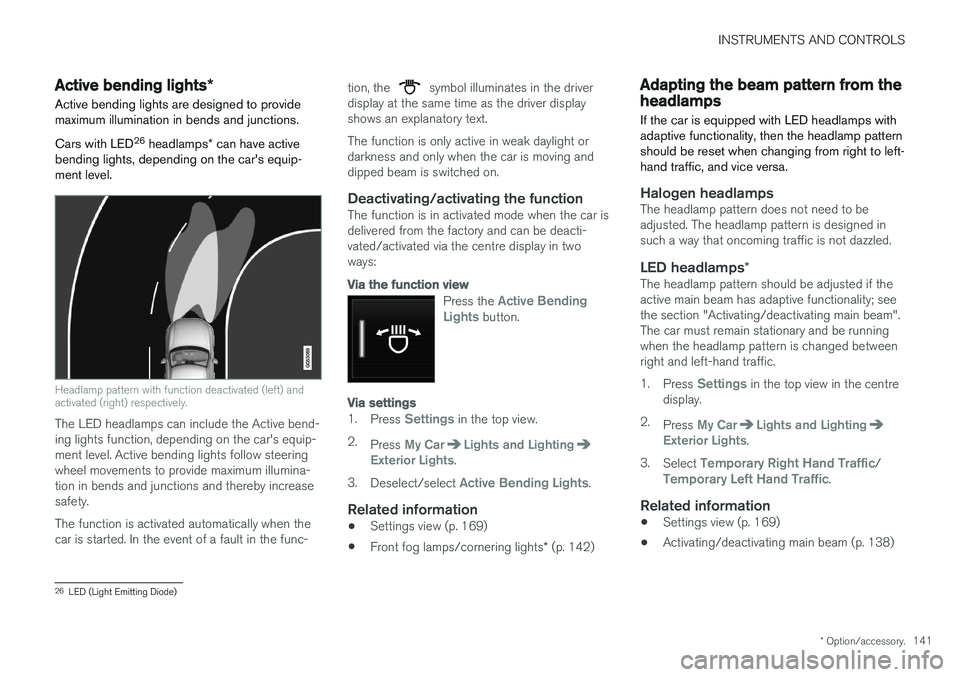
INSTRUMENTS AND CONTROLS
* Option/accessory.141
Active bending lights *
Active bending lights are designed to provide maximum illumination in bends and junctions. Cars with LED 26
headlamps * can have active
bending lights, depending on the car's equip- ment level.
Headlamp pattern with function deactivated (left) and activated (right) respectively.
The LED headlamps can include the Active bend- ing lights function, depending on the car's equip-ment level. Active bending lights follow steeringwheel movements to provide maximum illumina-tion in bends and junctions and thereby increasesafety. The function is activated automatically when the car is started. In the event of a fault in the func- tion, the
symbol illuminates in the driver
display at the same time as the driver display shows an explanatory text. The function is only active in weak daylight or darkness and only when the car is moving anddipped beam is switched on.
Deactivating/activating the functionThe function is in activated mode when the car isdelivered from the factory and can be deacti-vated/activated via the centre display in twoways:
Via the function view
Press the Active Bending
Lights button.
Via settings
1. Press Settings in the top view.
2. Press
My CarLights and LightingExterior Lights.
3. Deselect/select
Active Bending Lights.
Related information
• Settings view (p. 169)
• Front fog lamps/cornering lights
* (p. 142)
Adapting the beam pattern from the headlamps
If the car is equipped with LED headlamps with adaptive functionality, then the headlamp patternshould be reset when changing from right to left-hand traffic, and vice versa.
Halogen headlampsThe headlamp pattern does not need to be adjusted. The headlamp pattern is designed insuch a way that oncoming traffic is not dazzled.
LED headlamps *The headlamp pattern should be adjusted if theactive main beam has adaptive functionality; seethe section "Activating/deactivating main beam".The car must remain stationary and be runningwhen the headlamp pattern is changed betweenright and left-hand traffic. 1.
Press
Settings in the top view in the centre
display.
2. Press
My CarLights and LightingExterior Lights.
3. Select
Temporary Right Hand Traffic/Temporary Left Hand Traffic.
Related information
• Settings view (p. 169)
• Activating/deactivating main beam (p. 138)
26
LED (Light Emitting Diode)
Page 144 of 594
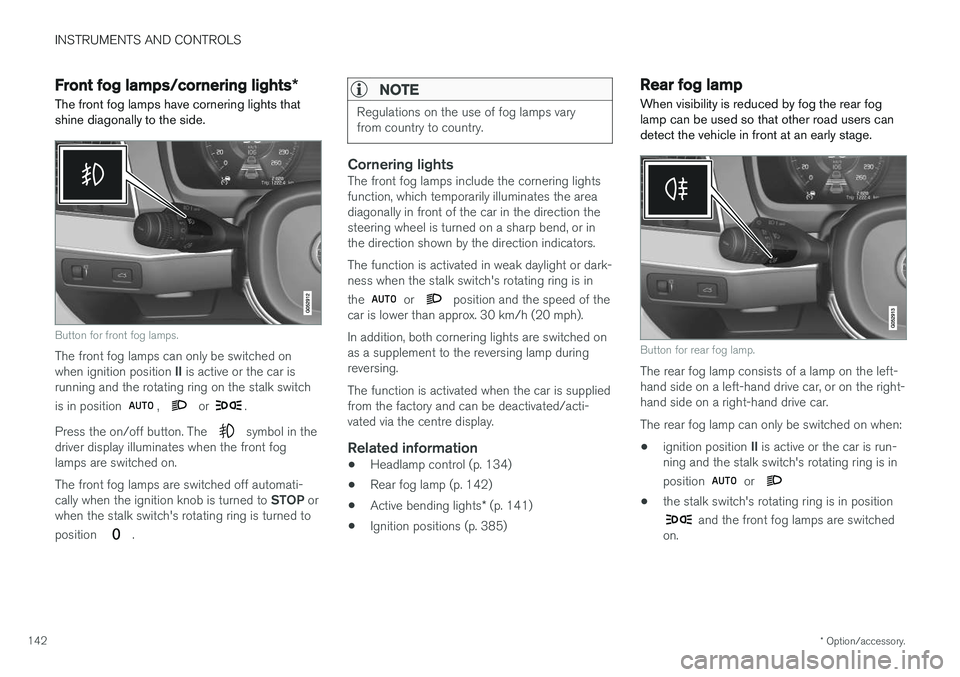
INSTRUMENTS AND CONTROLS
* Option/accessory.
142
Front fog lamps/cornering lights *
The front fog lamps have cornering lights that shine diagonally to the side.
Button for front fog lamps.
The front fog lamps can only be switched on when ignition position II is active or the car is
running and the rotating ring on the stalk switch is in position
, or .
Press the on/off button. The
symbol in the
driver display illuminates when the front fog lamps are switched on. The front fog lamps are switched off automati- cally when the ignition knob is turned to STOP or
when the stalk switch's rotating ring is turned to position
.
NOTE
Regulations on the use of fog lamps vary from country to country.
Cornering lightsThe front fog lamps include the cornering lights function, which temporarily illuminates the areadiagonally in front of the car in the direction thesteering wheel is turned on a sharp bend, or inthe direction shown by the direction indicators. The function is activated in weak daylight or dark- ness when the stalk switch's rotating ring is in the
or position and the speed of the
car is lower than approx. 30 km/h (20 mph). In addition, both cornering lights are switched on as a supplement to the reversing lamp duringreversing. The function is activated when the car is supplied from the factory and can be deactivated/acti-vated via the centre display.
Related information
• Headlamp control (p. 134)
• Rear fog lamp (p. 142)
• Active bending lights
* (p. 141)
• Ignition positions (p. 385)
Rear fog lamp
When visibility is reduced by fog the rear fog lamp can be used so that other road users candetect the vehicle in front at an early stage.
Button for rear fog lamp.
The rear fog lamp consists of a lamp on the left- hand side on a left-hand drive car, or on the right-hand side on a right-hand drive car. The rear fog lamp can only be switched on when:
• ignition position
II is active or the car is run-
ning and the stalk switch's rotating ring is in position
or
• the stalk switch's rotating ring is in position
and the front fog lamps are switched
on.
Page 145 of 594
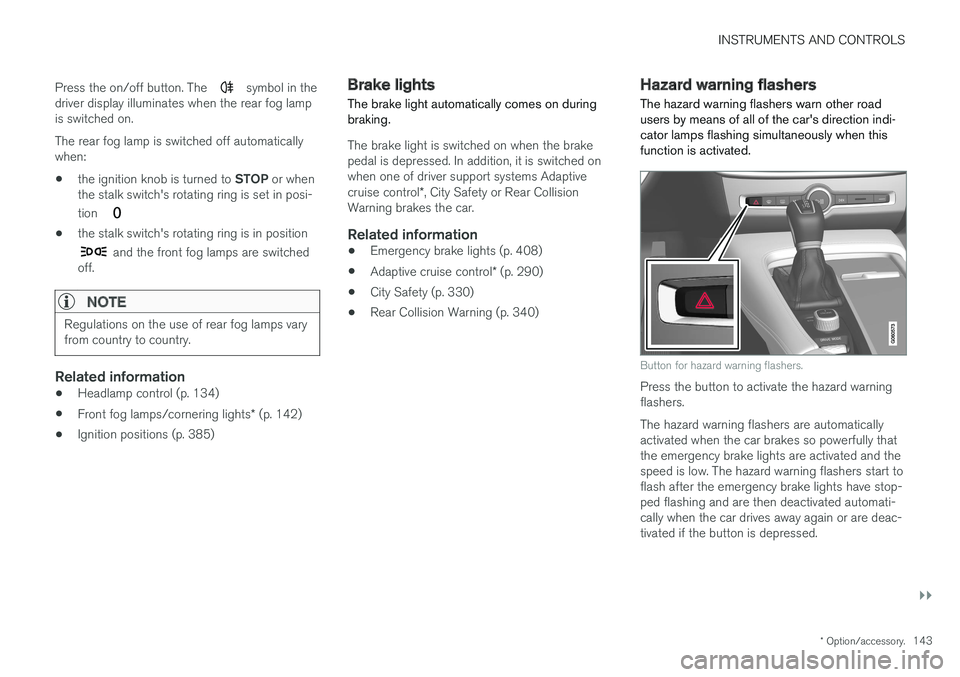
INSTRUMENTS AND CONTROLS
}}
* Option/accessory.143
Press the on/off button. The
symbol in the
driver display illuminates when the rear fog lamp is switched on. The rear fog lamp is switched off automatically when:
• the ignition knob is turned to
STOP or when
the stalk switch's rotating ring is set in posi- tion
• the stalk switch's rotating ring is in position
and the front fog lamps are switched
off.
NOTE
Regulations on the use of rear fog lamps vary from country to country.
Related information
• Headlamp control (p. 134)
• Front fog lamps/cornering lights
* (p. 142)
• Ignition positions (p. 385)
Brake lights The brake light automatically comes on during braking.
The brake light is switched on when the brake pedal is depressed. In addition, it is switched onwhen one of driver support systems Adaptive cruise control
*, City Safety or Rear Collision
Warning brakes the car.
Related information
• Emergency brake lights (p. 408)
• Adaptive cruise control
* (p. 290)
• City Safety (p. 330)
• Rear Collision Warning (p. 340)
Hazard warning flashers
The hazard warning flashers warn other road users by means of all of the car's direction indi-cator lamps flashing simultaneously when thisfunction is activated.
Button for hazard warning flashers.
Press the button to activate the hazard warning flashers. The hazard warning flashers are automatically activated when the car brakes so powerfully thatthe emergency brake lights are activated and thespeed is low. The hazard warning flashers start toflash after the emergency brake lights have stop-ped flashing and are then deactivated automati-cally when the car drives away again or are deac-tivated if the button is depressed.
Page 146 of 594
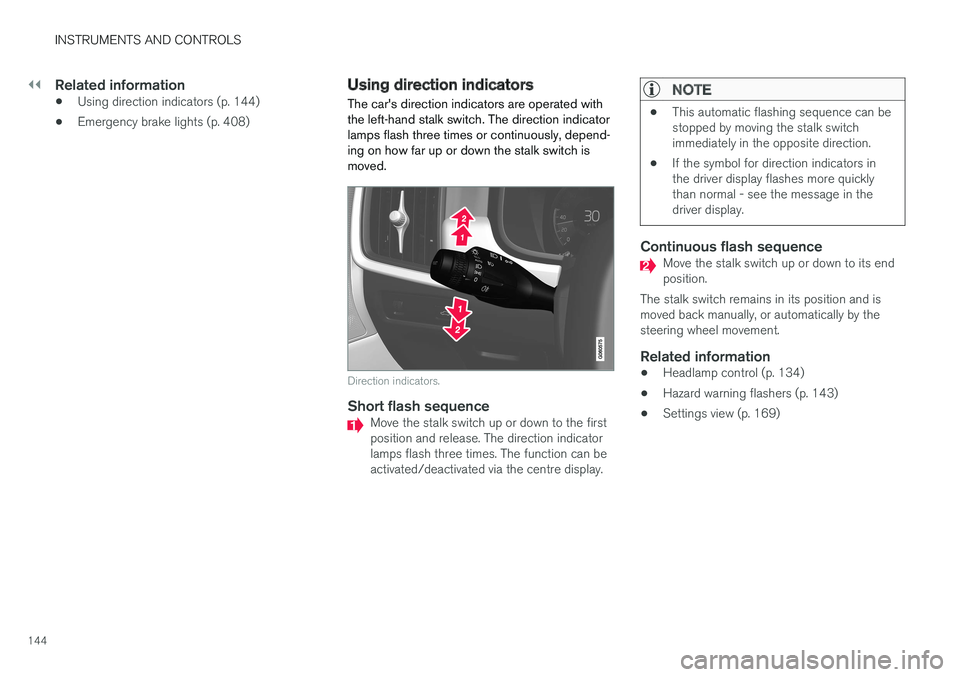
||
INSTRUMENTS AND CONTROLS
144
Related information
•Using direction indicators (p. 144)
• Emergency brake lights (p. 408)
Using direction indicators
The car's direction indicators are operated with the left-hand stalk switch. The direction indicatorlamps flash three times or continuously, depend-ing on how far up or down the stalk switch ismoved.
Direction indicators.
Short flash sequenceMove the stalk switch up or down to the first position and release. The direction indicatorlamps flash three times. The function can beactivated/deactivated via the centre display.
NOTE
• This automatic flashing sequence can be stopped by moving the stalk switchimmediately in the opposite direction.
• If the symbol for direction indicators inthe driver display flashes more quicklythan normal - see the message in thedriver display.
Continuous flash sequenceMove the stalk switch up or down to its end position.
The stalk switch remains in its position and ismoved back manually, or automatically by thesteering wheel movement.
Related information
• Headlamp control (p. 134)
• Hazard warning flashers (p. 143)
• Settings view (p. 169)
Page 149 of 594

INSTRUMENTS AND CONTROLS
147
The ambience lights can be changed via the cen- tre display:
Changing the brightness of the lights
1.
Press Settings in the top view in the centre
display.
2. Press
My CarLights and Lighting
Interior LightingInterior Mood Lighting.
3. Under
Interior Mood Light Intensity, select
from Off, Low and High.
Changing the colour of the light
1. Press Settings in the top view in the centre
display.
2. Press
My CarLights and Lighting
Interior LightingInterior Mood Lighting.
3. Choose between
By Temperature, By
Colour and Theme Colours in order to
change the colour of the light. With colour option
By Temperature, the
colour of the light changes according to the set passenger compartment temperature.
Controls located next to the steering wheel.
The intensity of the ambience light can be adjusted using the controls in the instrumentpanel:
–Turn the thumbwheel to adjust the intensity.
Lighting in storage compartments in doors
The lighting in storage compartments in doors is switched on when the car is running. The bright-ness can be finely adjusted using the control inthe instrument panel.
Lighting in front cup holders in tunnel
console
The lighting in the front cup holders is switchedon when the car is unlocked and is switched offwhen the car is locked. The brightness can befinely adjusted using the control in the instrumentpanel.
Related information
• Headlamp control (p. 134)
• Ignition positions (p. 385)
• Settings view (p. 169)
Page 151 of 594
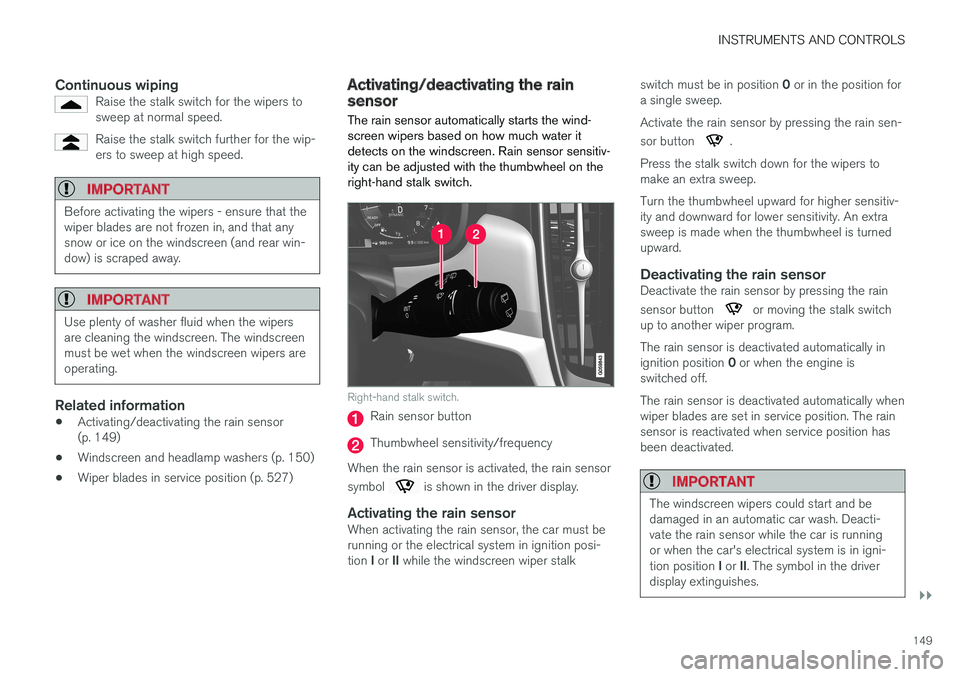
INSTRUMENTS AND CONTROLS
}}
149
Continuous wipingRaise the stalk switch for the wipers to sweep at normal speed.
Raise the stalk switch further for the wip- ers to sweep at high speed.
IMPORTANT
Before activating the wipers - ensure that the wiper blades are not frozen in, and that anysnow or ice on the windscreen (and rear win-dow) is scraped away.
IMPORTANT
Use plenty of washer fluid when the wipers are cleaning the windscreen. The windscreenmust be wet when the windscreen wipers areoperating.
Related information
•Activating/deactivating the rain sensor (p. 149)
• Windscreen and headlamp washers (p. 150)
• Wiper blades in service position (p. 527)
Activating/deactivating the rain sensor
The rain sensor automatically starts the wind- screen wipers based on how much water itdetects on the windscreen. Rain sensor sensitiv-ity can be adjusted with the thumbwheel on theright-hand stalk switch.
Right-hand stalk switch.
Rain sensor button
Thumbwheel sensitivity/frequency
When the rain sensor is activated, the rain sensor symbol
is shown in the driver display.
Activating the rain sensorWhen activating the rain sensor, the car must be running or the electrical system in ignition posi- tion I or II while the windscreen wiper stalk switch must be in position
0 or in the position for
a single sweep. Activate the rain sensor by pressing the rain sen- sor button
.
Press the stalk switch down for the wipers to make an extra sweep. Turn the thumbwheel upward for higher sensitiv- ity and downward for lower sensitivity. An extrasweep is made when the thumbwheel is turnedupward.
Deactivating the rain sensorDeactivate the rain sensor by pressing the rain sensor button
or moving the stalk switch
up to another wiper program. The rain sensor is deactivated automatically in ignition position 0 or when the engine is
switched off. The rain sensor is deactivated automatically when wiper blades are set in service position. The rainsensor is reactivated when service position hasbeen deactivated.
IMPORTANT
The windscreen wipers could start and be damaged in an automatic car wash. Deacti-vate the rain sensor while the car is runningor when the car's electrical system is in igni- tion position I or II. The symbol in the driver
display extinguishes.
Page 152 of 594
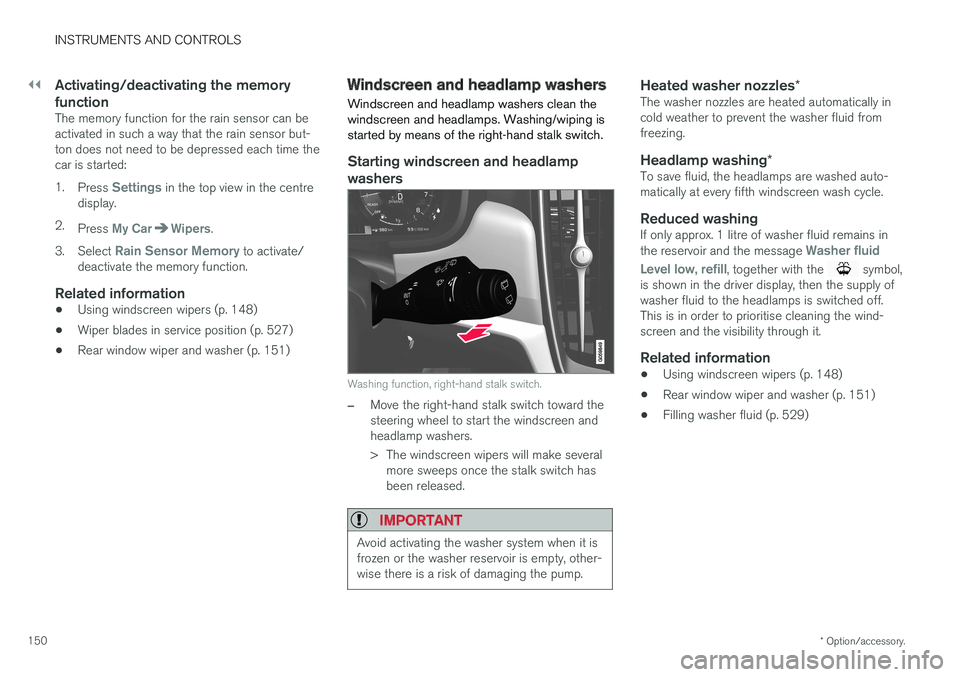
||
INSTRUMENTS AND CONTROLS
* Option/accessory.
150
Activating/deactivating the memory function
The memory function for the rain sensor can be activated in such a way that the rain sensor but-ton does not need to be depressed each time thecar is started: 1.
Press
Settings in the top view in the centre
display.
2. Press
My CarWipers.
3. Select
Rain Sensor Memory to activate/
deactivate the memory function.
Related information
• Using windscreen wipers (p. 148)
• Wiper blades in service position (p. 527)
• Rear window wiper and washer (p. 151)
Windscreen and headlamp washers
Windscreen and headlamp washers clean the windscreen and headlamps. Washing/wiping isstarted by means of the right-hand stalk switch.
Starting windscreen and headlamp
washers
Washing function, right-hand stalk switch.
–Move the right-hand stalk switch toward the steering wheel to start the windscreen andheadlamp washers.
> The windscreen wipers will make several more sweeps once the stalk switch has been released.
IMPORTANT
Avoid activating the washer system when it is frozen or the washer reservoir is empty, other-wise there is a risk of damaging the pump.
Heated washer nozzles *The washer nozzles are heated automatically in cold weather to prevent the washer fluid fromfreezing.
Headlamp washing*To save fluid, the headlamps are washed auto-matically at every fifth windscreen wash cycle.
Reduced washingIf only approx. 1 litre of washer fluid remains in the reservoir and the message Washer fluid
Level low, refill
, together with the symbol,
is shown in the driver display, then the supply of washer fluid to the headlamps is switched off.This is in order to prioritise cleaning the wind-screen and the visibility through it.
Related information
• Using windscreen wipers (p. 148)
• Rear window wiper and washer (p. 151)
• Filling washer fluid (p. 529)
Page 153 of 594
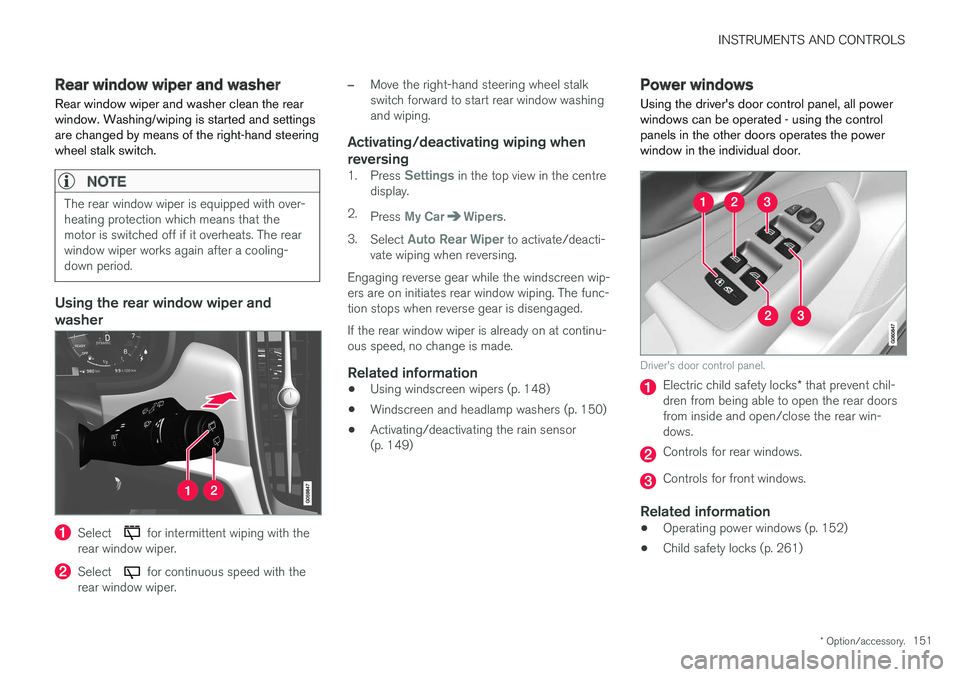
INSTRUMENTS AND CONTROLS
* Option/accessory.151
Rear window wiper and washer
Rear window wiper and washer clean the rear window. Washing/wiping is started and settingsare changed by means of the right-hand steeringwheel stalk switch.
NOTE
The rear window wiper is equipped with over- heating protection which means that themotor is switched off if it overheats. The rearwindow wiper works again after a cooling-down period.
Using the rear window wiper and washer
Select for intermittent wiping with the
rear window wiper.
Select for continuous speed with the
rear window wiper.
–Move the right-hand steering wheel stalk switch forward to start rear window washingand wiping.
Activating/deactivating wiping when reversing
1. Press Settings in the top view in the centre
display.
2. Press
My CarWipers.
3. Select
Auto Rear Wiper to activate/deacti-
vate wiping when reversing.
Engaging reverse gear while the windscreen wip- ers are on initiates rear window wiping. The func- tion stops when reverse gear is disengaged. If the rear window wiper is already on at continu- ous speed, no change is made.
Related information
• Using windscreen wipers (p. 148)
• Windscreen and headlamp washers (p. 150)
• Activating/deactivating the rain sensor(p. 149)
Power windows
Using the driver's door control panel, all power windows can be operated - using the controlpanels in the other doors operates the powerwindow in the individual door.
Driver's door control panel.
Electric child safety locks * that prevent chil-
dren from being able to open the rear doors from inside and open/close the rear win-dows.
Controls for rear windows.
Controls for front windows.
Related information
• Operating power windows (p. 152)
• Child safety locks (p. 261)
Page 338 of 594
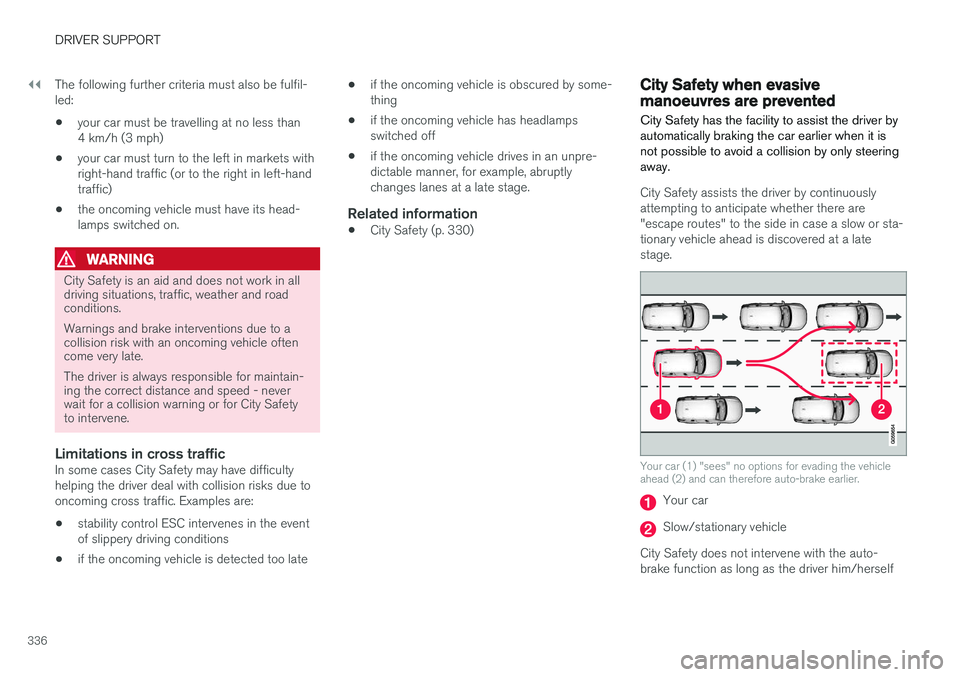
||
DRIVER SUPPORT
336The following further criteria must also be fulfil- led:
• your car must be travelling at no less than4 km/h (3 mph)
• your car must turn to the left in markets withright-hand traffic (or to the right in left-handtraffic)
• the oncoming vehicle must have its head-lamps switched on.
WARNING
City Safety is an aid and does not work in all driving situations, traffic, weather and roadconditions. Warnings and brake interventions due to a collision risk with an oncoming vehicle oftencome very late. The driver is always responsible for maintain- ing the correct distance and speed - neverwait for a collision warning or for City Safetyto intervene.
Limitations in cross trafficIn some cases City Safety may have difficulty helping the driver deal with collision risks due tooncoming cross traffic. Examples are:
• stability control ESC intervenes in the eventof slippery driving conditions
• if the oncoming vehicle is detected too late •
if the oncoming vehicle is obscured by some-thing
• if the oncoming vehicle has headlampsswitched off
• if the oncoming vehicle drives in an unpre-dictable manner, for example, abruptlychanges lanes at a late stage.
Related information
•
City Safety (p. 330)
City Safety when evasive manoeuvres are prevented City Safety has the facility to assist the driver by automatically braking the car earlier when it isnot possible to avoid a collision by only steeringaway.
City Safety assists the driver by continuously attempting to anticipate whether there are"escape routes" to the side in case a slow or sta-tionary vehicle ahead is discovered at a latestage.
Your car (1) "sees" no options for evading the vehicle ahead (2) and can therefore auto-brake earlier.
Your car
Slow/stationary vehicle
City Safety does not intervene with the auto- brake function as long as the driver him/herself